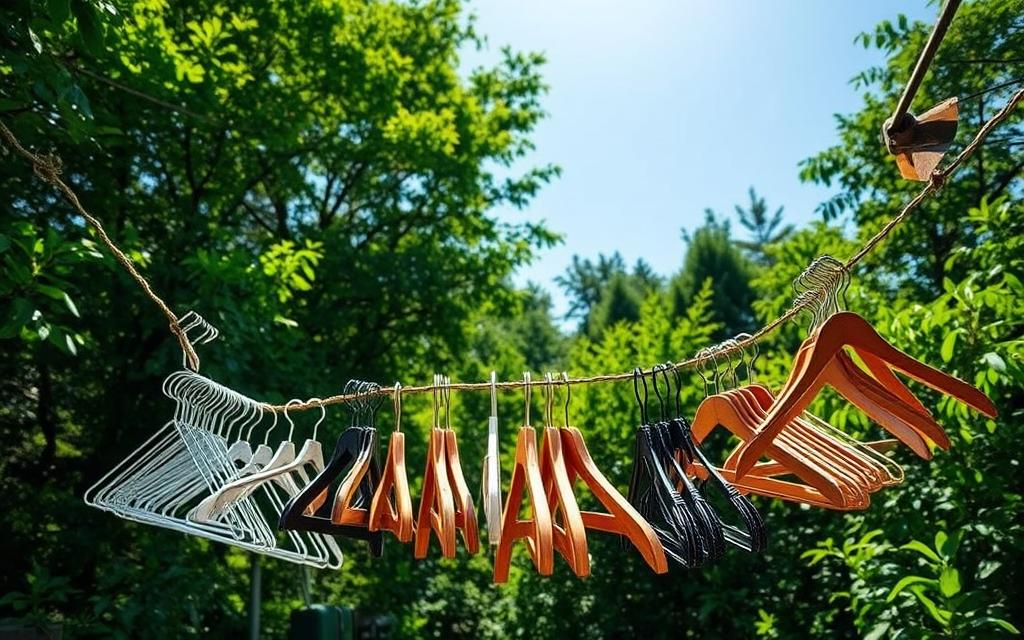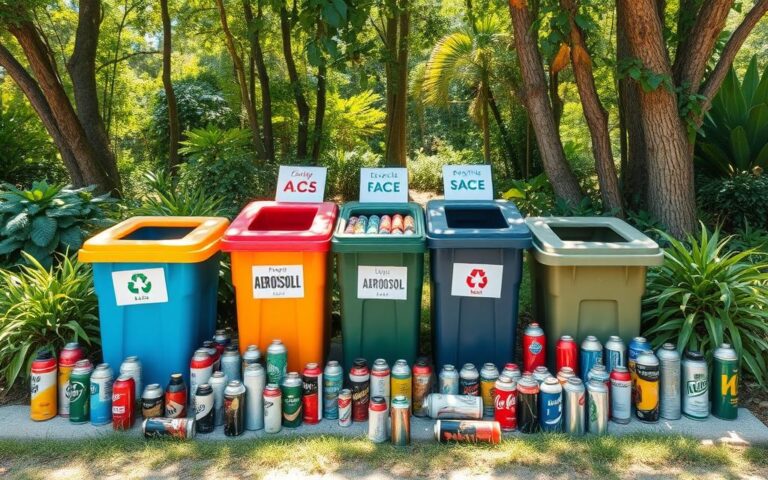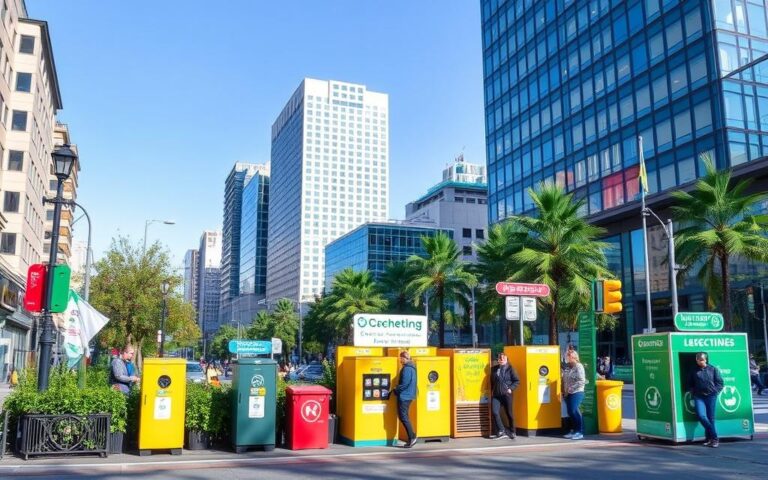Can I Recycle Clothes Hangers? Sustainable Disposal Options
As we become more conscious of our impact on the earth, we often ask: can I recycle clothes hangers? These items, though small, contribute to a large plastic waste issue. About 40 billion hangers are used every year. Astonishingly, 85% of new plastic hangers end up being thrown away.
This shows the importance of choosing eco-friendly ways to dispose of them. This article will help you understand how to manage hangers sustainably. It looks into the broader issue of plastic waste. By learning and making better choices, we can all help lessen our mark on the planet.
The Environmental Impact of Clothes Hangers
Clothes hangers are a big problem for the environment. Every year, 40 billion plastic hangers are made. About 8 billion of these end up in landfills. This adds to pollution and waste issues.
Plastic hangers can take up to 500 years to break down. While they last, they can harm ecosystems. They release dangerous chemicals like benzene and BPA.
Plastic Hangers and Their Longevity
Plastic hangers are not great for the environment. They are made of different plastics and metals. This makes them hard to recycle. Sadly, 85% of hangers are thrown away.
Recycling hangers helps cut down carbon emissions. For example, recycling a billion hangers a year can save as much CO2 as 10.6 billion plastic straws. We must choose more recyclable and eco-friendly materials.
The Photodegradation of Plastic
Photodegradation makes the problem worse. When sunlight hits plastic hangers, they break down into tiny pieces. These are called microplastics. They spread through soil and water.
Microplastics harm wildlife and enter the food chain. This affects our health too. Millions of plastic hangers break down into microplastics each year. We need sustainable clothing and hanger solutions. It’s time to cut down on single-use plastics.
Can I Recycle Clothes Hangers?
Many wonder if clothes hangers can be successfully recycled, as they pose recycling challenges. They are usually made from plastic, like polystyrene, which is plastic type six. This type is hard for many recycling plants to process. The mix of materials, like metal, makes recycling even harder.
Recycling Challenges with Plastic Hangers
Plastic hangers are tough to recycle because they come in various plastic types. Often, they’re made from polystyrene or number seven plastic. Not showing recycling symbols makes it hard to tell which can be recycled. With no proper facilities to recycle them, over 30 million hangers end up in landfills daily.
Are Other Types of Hangers Recyclable?
Different hangers have different rules. Wooden hangers, more eco-friendly, cannot be recycled if they have varnish. Wire hangers, however, can sometimes be recycled. New York City, for example, recycles metal hangers in curbside pickups. Organisations like the Salvation Army will take plastic hangers, but Goodwill won’t take any hangers. This shows why knowing your local recycling rules is vital.
| Type of Hanger | Material | Recyclable | Local Recycling Options |
|---|---|---|---|
| Plastic Hangers | Polystyrene (Plastic No. 6) | No | Typically not accepted |
| Wooden Hangers | Wood with varnish | No | No recycling facilities |
| Wire Hangers | Steel with plastic coating | Sometimes | Varies by city |
| Eco-Friendly Hangers | Recycled materials | Yes | Accessible through specific manufacturers |
Alternatives to Recycling Clothes Hangers
If you want to make green choices with clothes hangers, there are many options besides recycling. Unused hangers can be given a new purpose through donating or repurposing. This helps create a sustainable lifestyle at home.
Donation Options for Unused Hangers
Donating hangers is a simple way to cut down on waste. You can give them to second-hand stores or local groups. Stores like Goodwill need them for hanging clothes. Schools and community centres might use them for arts and crafts. Giving hangers away helps your community and keeps waste out of landfills.
Creative Repurposing Ideas
Old hangers are great for creative recycling. They can turn into new items for your home or crafts. Here are some fun ideas:
- Make unique wall art or photo displays out of hangers.
- Build a decorative pot rack to organise your kitchen.
- Use hangers to form wreaths for festive decorations.
- Create a shoe rack by joining several hangers together.
These repurposing ideas breathe new life into old hangers. They also promote thinking sustainably. Being creative with what you have helps reduce plastic waste.

For more insights on why recycling matters, check out this resource. It talks about sustainable ways to dispose of items. It also discusses making eco-friendly choices in our shopping habits.
Sustainable Materials for Replacement Hangers
Moving towards sustainable materials is key to solving environmental issues from plastic hangers. Every year, we waste between 6-20 billion plastic hangers. Bamboo and cardboard hangers are getting popular as alternatives. These green hangers cut down waste and help our planet stay healthy.
Bamboo Hangers: A Renewable Alternative
Bamboo hangers are a top choice for those looking for a green option. Bamboo grows quickly and doesn’t need much to thrive, making it an eco-friendly choice. Unlike plastic hangers, bamboo ones are strong and look good. They make our closets better and are kinder to the environment.
Cardboard Hangers and Their Benefits
Cardboard hangers are another great eco-friendly choice. They may not last as long as bamboo, but they are light and easy to recycle. Cardboard hangers lower the environmental harm of plastic ones. They are made from renewable materials and can be recycled. Using them helps manage waste better and keeps compostable materials out of landfills.
| Type of Hanger | Durability | Environmental Impact | Recyclability |
|---|---|---|---|
| Plastic Hangers | Low | High carbon footprint, long degradation time | Limited |
| Bamboo Hangers | High | Low carbon footprint, renewable | Yes |
| Cardboard Hangers | Medium | Low pollution potential, recyclable | Yes |
Choosing green hangers like those made of bamboo or cardboard shows we care for sustainability. This choice benefits not only us but also educates communities about environmental care.
Local Recycling Programs and Initiatives
Understanding local recycling programmes helps us make better choices about clothes hangers. Many places have set up systems to help with recycling, but the options can vary a lot. By getting involved in these programmes, we can help a lot with sustainability efforts.
Companies with Take-Back Programs
Big retailers like Target and Walmart have started take-back schemes. These encourage people to bring back used clothes hangers. Target has been offering recycling kiosks at the front of their stores since 2010. Thanks to this, they have managed to keep thousands of tons of recyclable things, like plastic hangers and ink cartridges, out of landfills.
How to Check Local Recycling Options
It’s easy and helpful to find out what your local recycling options are. Many local authorities have websites that list what you can and can’t recycle. In Philadelphia, for example, people can see exactly what’s accepted for recycling and what’s not. It’s really important to make sure clothes hangers are recyclable in your area. This helps avoid problems and makes recycling work better. Taking part in local recycling can make our sustainability efforts even stronger.
Conclusion
Understanding how to recycle clothes hangers is key to better disposal methods. Around 10 billion hangers are made yearly. Sadly, only about 15% get recycled. If we pay attention to the small stuff, we can help our planet a lot.
It’s important to know that every action matters. The use of plastic and metal hangers leads to billions ending up in landfills. They stay there for hundreds of years. We can choose other options, give away hangers we don’t use, or find creative ways to reuse them. Doing so helps reduce waste and inspires others to think about recycling.
In the end, knowing how to dispose of hangers properly can lead to a culture of sustainability. By pushing for recycling and careful handling of hangers, we all contribute to a cleaner world. The path to a sustainable future starts with our everyday choices and habits.
FAQ
Can I recycle plastic clothes hangers?
Most recycling places can’t take plastic hangers because they are hard to recycle. It’s vital to check your area’s rules. Some places might allow them.
What is the environmental impact of plastic hangers?
Plastic hangers don’t break down easily, taking hundreds of years to decompose. This harms ecosystems. When they do break down, they release dangerous chemicals into our environment.
Are there eco-friendly alternatives to plastic hangers?
Yes, you can use bamboo or cardboard hangers instead. Bamboo is strong and renewable. Cardboard can be recycled easily, cutting down on plastic.
What should I do with unused hangers?
Consider giving them away to shops, schools, or groups in need. Or, get creative and make new things for your home.
How can I find local recycling options for clothes hangers?
Check with your community’s recycling schemes or stores like Target and Walmart. They sometimes offer recycling for hangers. Your local area can guide you on what they accept.
What are the benefits of using bamboo hangers?
Bamboo hangers look good and last longer than plastic ones. They are made from a renewable source, making them greener for organising your closet.
Can I recycle wire hangers?
You might be able to recycle wire hangers, but it varies by location. Check if your local centre accepts them or if they need to go to a scrap yard.
What is TerraCycle and how does it relate to clothes hanger recycling?
TerraCycle specialises in recycling tough materials, including some plastics. Joining their programs might help recycle hangers that your local spot won’t take.















